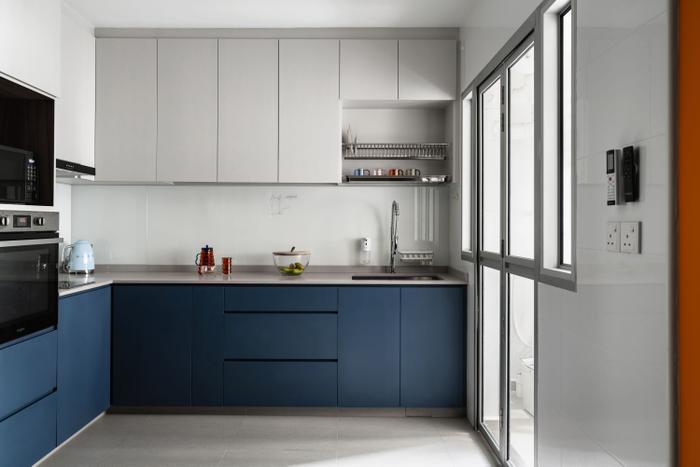Experiencing nausea, headaches, or irritation after renovation? These sources may be the cause.
After spending months planning and renovating your new home, the last thing you want to do is to fall sick right after moving in. We’re not talking about the regular cold or fever – rather, it involves things like sinus infections, eye irritation, and headaches that come out of seemingly nowhere.

Source: Singapore Renovation
If you can’t pinpoint the cause of your symptoms, it might just be from your renovation. Aside from the usual culprits like lingering dust and dirt, the materials used can also be a huge contributing factor, as they produce harmful chemicals like volatile organic compounds (VOCs) such as formaldehyde.
Here, we’ve listed them down, as well as safer alternatives you can consider.
1. Carpentry works

View this project by R INTERIOR | R 设计团队
Given the space constraints in homes throughout Singapore, you could say that carpentry is essential in helping us make the most of every inch available. But what if we told you that they’re potentially one of the major causes of sickness after your renovation?
Well, it’s true – and that’s because of the formaldehyde emanating from the adhesives and resin used in composite wood products like particleboard and medium-density fiberboard (MDF), both of which are commonly used for carpentry works.

View this project by Oblivion Lab
Safer alternative: Unfortunately, there is no such thing as a ‘formaldehyde-free’ wood product, because it occurs naturally across all wood species. Instead, consider looking for firms that use low-emission wood like Ecoply*, which is a type of plywood that emits a significantly lesser amount of formaldehyde compared to other types of wood.
Alternatively, you can also consider materials like stainless steel – they’re not only non-toxic, but also easy to clean and durable.
*Interior design firms like Design 4 Space specifically use Ecoply in all of their carpentry works – for additional information, feel free to contact them directly!
2. Paint

View this project by Forefront Interior
That ‘new paint’ smell you get with a fresh coat of paint? That’s coming from the volatile organic compounds (VOCs) that are released into the air as paint dries – which can result in both short-term and long-term health issues like sinus infections, headaches, and even cancer.
Safer alternative: Look for low- or zero-VOC paints, which are specially formulated such that they don’t contain harmful chemicals that produce strong smells.
If you’re thinking of doing away with paints entirely to go with wallpaper, well – you may want to read the next point first.
3. Wallpaper

View this project by Willis Design
“How can wallpaper be toxic? Isn’t it just paper?” Well, not quite – for additional durability and easier maintenance, they’re often made from polyvinyl chloride (PVC), which are more durable and easier to maintain.
The downside, though, is that they tend to release harmful chemicals and additives into the air – in severe cases, long-term exposure could lead to symptoms like heart palpitations, fainting spells, and dizziness.
On top of that, the ink used to create the design can also contain VOCs – so they’re not as safe as you think!
Safer alternative: Look out for wallpapers made from natural materials, like fleece, flax, or recycled materials. Pigments and inks should also be organic or made from safe synthetics (e.g. water-based pigments).
4. Vinyl flooring

View this project by Attic Studio Interiors
While vinyl has become one of the most popular flooring choices due to its affordability and ease of maintenance, it does have its drawbacks – namely, the potential health risk to not only your household members, but your pets as well!
Like wallpaper, vinyl is made with PVC, but on top of that, it’s also treated with phthalates – a PVC softener that can also cause dizziness and nausea with long-term exposure.
Safer alternative: If you’re still keen on getting vinyl flooring, look for brands with non-toxic flooring that use organic plasticisers. If not, consider safer choices such as linoleum or ceramic/porcelain tiles – for the latter, just ensure that the grout and adhesive used are non-toxic.
But how do I reduce formaldehyde and VOCs levels if I’ve already renovated my home?
If you’ve just renovated your home and are currently dealing with this issue, don’t worry – you don’t have to do yet another revamp just to fix it. Instead, consider minimising chemical emission rates by:
- Keeping your home well-ventilated by leaving your fans on and ensuring proper air circulation. Note that it can take several weeks for the smell to be gone.
- Reducing humidity levels at home. Studies have shown that formaldehyde emission rates are higher in more humid conditions, so keep your homes well-ventilated and invest in dehumidifying tools as much as possible.
- Getting an air purifier with a carbon filter. Carbon (or charcoal) removes contaminants by trapping them within its porous structure, thus preventing them from circulating back into the air. One example that has this feature is Dyson’s latest air purifier model.
- Leaving a bowl of activated charcoal or formaldehyde removal gel in each room. Note that this isn’t meant to be a replacement for an actual air purifier, as charcoal only absorbs formaldehyde and VOCs, but not actual particulate matter.
- Engaging a professional specialising in indoor air treatment. A few examples of such professionals include UC Fresh Air, LAF, and JP Tree.
Note that any link or reference to a third-party website, product, or service in this article are provided purely as examples, and does not imply an endorsement or recommendation by Qanvast.

 Get a budget estimate before meeting IDs
Get a budget estimate before meeting IDs